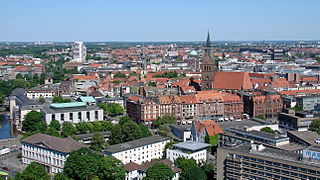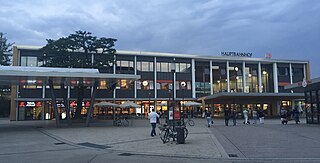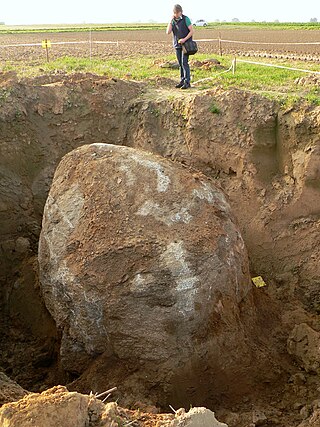Related Research Articles

Hanover is the capital and largest city of the German state of Lower Saxony. Its 535,932 (2021) population makes it the 13th-largest city in Germany as well as the fourth-largest city in northern Germany after Berlin, Hamburg and Bremen. Hanover's urban area comprises the towns of Garbsen, Langenhagen and Laatzen and has a population of about 791,000 (2018). The Hanover Region has approximately 1.16 million inhabitants (2019) and is the largest in the Hannover–Braunschweig–Göttingen–Wolfsburg Metropolitan Region.

Chert is a hard, fine-grained sedimentary rock composed of microcrystalline or cryptocrystalline quartz, the mineral form of silicon dioxide (SiO2). Chert is characteristically of biological origin, but may also occur inorganically as a chemical precipitate or a diagenetic replacement, as in petrified wood.

Hannoverscher Sportverein von 1896, commonly referred to as Hannover 96, Hannover or simply 96, is a German professional football club based in the city of Hanover, Lower Saxony. They played in the Bundesliga for a total of 30 years between 1964 and 2019 and currently play in the 2. Bundesliga, the second tier in the German football league system, having been relegated from the Bundesliga, Germany's first tier, after finishing 17th in the 2018–19 season.
The district of Aachen is a district in the west of North Rhine-Westphalia, Germany. Neighboring districts are Heinsberg, Düren, Euskirchen, and also the Netherlands province of Limburg and the Belgian province of Liège. Its administrative body is the Städteregionsparlament, headed by the Städteregionspräsident or "region president".

Francis Buchholz is a German musician best known as the bass guitarist of German rock band Scorpions from 1973 until 1992. Since leaving Scorpions, he has been a member of Michael Schenker's Temple of Rock.

Robert Enke was a German professional footballer who played as a goalkeeper.

Hannover Hauptbahnhof is the main railway station for the city of Hanover in Lower Saxony, Germany. The railway junction is one of the 21 stations listed as a railway Category 1 station by DB Station&Service. It is also the most important public transport hub of the region of Hanover and it is served regional and S-Bahn services. The station has six platforms with twelve platform tracks, and two through tracks without platforms. Every day it is used by 250,000 passengers and 622 trains stop at the platforms. About 2,000 people work here.
German punk includes a body of music and a subculture that have evolved since punk rock became popular in Germany in the 1970s. Within the subculture of punk in Germany, a style of music called Deutschpunk was developed; this style of music has developed distinctly from hardcore punk, and includes lyrics in German as well as a fast tempo. In the punk scene in Germany, some bands play music in the Deutschpunk style, while other German punk bands pursue various other styles of punk music.

Gau Eastern Hanover was a regional district of the NSDAP established in 1925 in the north eastern part of the Prussian Province of Hanover, comprising the governorates of Stade and Lüneburg in their then boundaries. Originally called Gau Stade-Lüneburg, it was renamed Gau Ost-Hannover on 1 October 1928. Initially, the Gau was a mere regional Nazi party subsection, but with the growing subjection of all public administration to Nazi party influence after the Machtergreifung, the Gau usurped from 1933 to 1935 more and more the functions of the Provincial government and its superordinate Free State of Prussia. However, after the German constituent states were de facto abolished in 1935, the Gaue replaced them in their responsibilities. Gau East Hannover - like all Nazi party structures - was dismantled after Nazi Germany's defeat in 1945. In 1946 the Control Commission for Germany - British Element (CCG/BE) reconstituted the Province of Hanover as the State of Hanover and later the same year it merged with three smaller neighbouring reconstituted German states to form the new state of Lower Saxony within the British Zone of Occupation. The municipality of Amt Neuhaus was allocated to Mecklenburg-Vorpommern.

The Upper Harz is the northwestern and higher part of the Harz mountain range in Germany. The exact boundaries of this geographical region may be defined differently depending on the context. In its traditional sense, the term Upper Harz covers the area of the seven historical mining towns (Bergstädte) - Clausthal, Zellerfeld, Andreasberg, Altenau, Lautenthal, Wildemann and Grund - in the present-day German federal state of Lower Saxony. Orographically, it comprises the Harz catchment areas of the Söse, Innerste and Grane, Oker and Abzucht mountain streams, all part of the larger Weser watershed.

Hildesheim Hauptbahnhof is the main railway station for the city of Hildesheim in Lower Saxony, Germany. The station opened in 1961 and is located on the Lehrte–Nordstemmen, Hildesheim–Brunswick and Hildesheim–Goslar railway. The train services are operated by DB Fernverkehr, Erixx, Metronom and NordWestBahn.

The Bomlitz is a right-bank tributary of the River Böhme in North Germany. It is just under 18 kilometres (11 mi) long and runs through the Heidekreis district in Lower Saxony.

The Calenberg is a hill in central Germany in the Leine depression near Pattensen in the municipality of Schulenburg. It lies 13 km west of the city of Hildesheim in south Lower Saxony on the edge of the Central Uplands. It is made from a chalk marl slab (Kalkmergelbank), has a height of 70 m above NN and was formed almost 100 million years ago at the beginning of the Upper Cretaceous series in Cenomanian stage. The Calenberg became historically important as a result of the fort, stronghold and castle built as the main residence of the House of Hanover.

Central Europe contains several life zones, depending on location and elevation.

Hanover University of Music, Drama and Media is a university of performing arts and media in Hanover, the capital of Lower Saxony, Germany. Dating to 1897, it has reorganised and changed names as it developed over the years, most recently in 2010 when it changed from State College of Music and Drama Hanover. Since 2010, its president has been Susanne Rode-Breymann. As of 2021, the university has 1,484 students and a total of 477 staff.

The New Town Church is a main Lutheran parish church in Hanover, Germany. Its official name is St. John's Church of the court and city in the New Town at Hanover. The Baroque church was built in 1666–70 and is one of the oldest Protestant aisleless churches in Lower Saxony, conceived for the sermon as the main act of the Lutheran church service. Mathematician and philosopher Gottfried Wilhelm Leibniz and Field Marshal Carl August von Alten are buried here.

The Colossus of Ostermunzel is a 27.5-tonne glacial erratic stone found in a farmer's field east of Ostermunzel in Lower Saxony, Germany, in 2013. It was excavated and moved to a new location a kilometre away.

The German: Reitwallstraße is a street in Hanover, Germany. Situated near the pedestrianised Stone Gate Square, it is part of the red-light district bounded by Reuterstraße, Goethestraße, Reitwallstraße and Am Marstall and is crossed by Scholvinstraße. The street is known for prostitution and strip clubs.

Hanover Historical Museum is an historical museum situated in Hanover, the capital of Lower Saxony, Germany. The museum was founded in 1903 as the Homeland Museum of the City of Hanover. Its collections are related to the history of the city, the history of the House of Guelf, and of the state of Lower Saxony.

The Wellheim Formation is a geological formation in southern Germany deposited during the Cenomanian to earliest Turonian stages of the Upper Cretaceous.
References
- ↑ Wilmsen, M (2003). "Sequence stratigraphy and palaeoceanography of the Cenomanian Stage in northern Germany". Cretaceous Research. 24 (5): 525–568. Bibcode:2003CrRes..24..525W. doi:10.1016/S0195-6671(03)00069-7. ISSN 0195-6671.
- ↑ Harms, F. J. (1984): Erläuterungen zu Blatt Nr. 4025 Freden. Niedersächsisches Landesamt für Bodenforschung, 168 S., Hannover.
- ↑ Jordan, H. (1968): Gliederung und Genese des Flammenmergels (Alb) in Hils- und Sackmulde. Z. dt. Geol. Ges., 117: 391-424, Hannover.